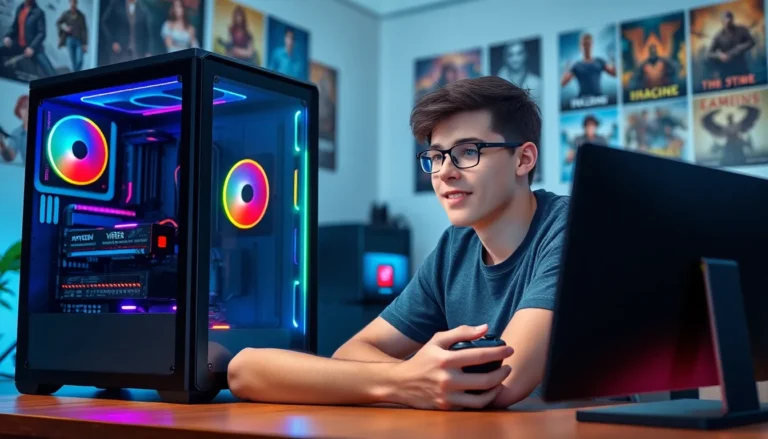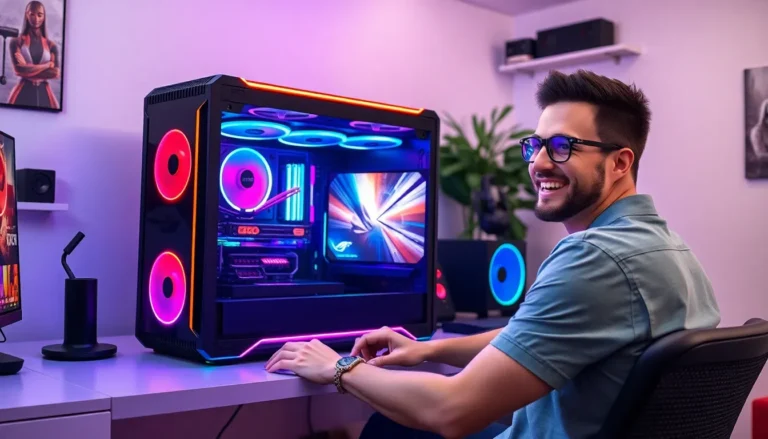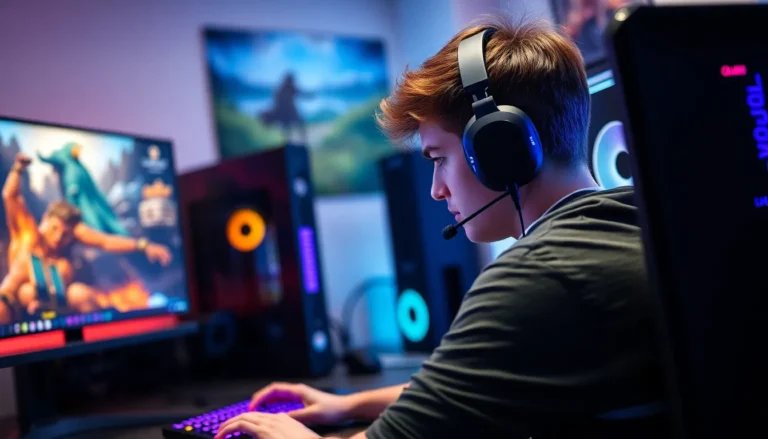In a world where gaming rigs often resemble small cars, the mini gaming PC build is like a sleek sports car zipping past the competition. These pint-sized powerhouses pack a punch, proving that good things really do come in small packages. If you’ve ever dreamed of dominating your favorite games without sacrificing precious desk space or your sanity, this guide is your golden ticket.
Imagine a gaming experience that fits right under your monitor—no more bulky towers taking over your room. With the right components, he or she can create a mini beast that runs like a dream while looking oh-so-stylish. Get ready to dive into the world of compact gaming, where performance meets portability, and your gaming setup can finally reflect your personality without overwhelming your space.
Mini Gaming PC Build
Mini gaming PCs combine compact design with solid performance, catering to gamers seeking efficient setups. These systems often utilize powerful components, proving that size does not limit gaming potential. Various options available in the market offer flexibility in performance specifications and aesthetics.
Choosing the right mini gaming PC requires considering compatibility between components. Essential parts include the CPU, GPU, RAM, and storage. A strong CPU significantly enhances multitasking capabilities while enabling efficient processing during intense gaming sessions. Equally important, the GPU determines graphics quality, maintaining smooth frame rates in demanding games.
Memory capacity also plays a crucial role in gameplay. Systems with at least 16 GB of RAM enhance responsiveness and loading times. Storage solutions vary, with SSDs providing faster data access compared to traditional HDDs. Opting for a combination of both can improve overall performance and loading speeds.
Cooling solutions become vital in mini builds, where space constraints can lead to overheating. Effective cooling options, including compact air coolers and all-in-one liquid cooling systems, ensure optimal performance without thermal throttling. Additionally, case design significantly impacts airflow, so selecting an appropriate case yields better results.
Ultimately, the goal is to balance performance, size, and aesthetics. Gamers can enjoy immersive experiences without sacrificing space or style. Building a mini gaming PC represents a perfect blend of technology and creativity, tailored to individual preferences.
Benefits of Building a Mini Gaming PC

Building a mini gaming PC offers numerous advantages that appeal to gamers looking for compact yet powerful systems. The benefits extend beyond just performance and aesthetics.
Space-Saving Design
Compact dimensions define mini gaming PCs. Gamers place these systems in tight spots without taking up excessive desk space. Designers often create them with sleek lines and appealing finishes, enhancing overall decor. Smaller builds encourage clean, organized setups, eliminating cable clutter. Some configurations allow for multi-display setups, efficiently utilizing available space. Transporting a mini gaming PC is simpler, benefiting gamers who travel for events or LAN parties. Positioning this rig in a bedroom or small apartment won’t hinder game performance or visual appeal.
Power Efficiency
Mini gaming PCs maintain impressive power efficiency through optimized components. Advanced processors and graphics cards consume less energy while delivering high FPS (frames per second). Integrated features reduce overall heat generation, minimizing the need for complex cooling solutions. These systems often use smaller power supplies, further lowering energy consumption. Efficient builds result in lower electricity bills, allowing gamers to enjoy prolonged gaming sessions economically. Sustainability becomes more manageable as small form factor setups contribute to reduced environmental impact. Gamers appreciate the balance of performance and eco-friendliness found in these compact systems.
Essential Components
Building a mini gaming PC requires careful selection of components to maximize performance while maintaining a compact form factor. Each part plays a crucial role, ensuring a seamless gaming experience.
Choosing the Right CPU
Selecting the right CPU is vital for multitasking and performance. A processor with multiple cores enhances efficiency during gaming and streaming. Current recommended models include AMD Ryzen 5 and Intel Core i5, as both deliver excellent performance for gaming setups. Compatibility with the chosen motherboard also matters; check socket types beforehand. Prioritize clock speed and thermal management to prevent overheating in tight spaces.
Selecting a Graphics Card
Choosing a suitable graphics card can significantly impact gaming visuals. Look for cards like the NVIDIA GeForce RTX 3060 or AMD Radeon RX 6600, as these provide superior frame rates at 1080p and 1440p resolutions. Ensure it fits within the case dimensions, as mini builds often restrict space. Power consumption is another critical factor; select a GPU that balances performance and energy efficiency. High-quality cooling solutions for the GPU also enhance longevity.
Motherboard Considerations
Picking the motherboard determines overall compatibility and features. Compact form factors such as Mini-ITX are ideal for mini gaming PCs. Ensure it supports advanced connectivity options like USB-C and Wi-Fi 6 for modern accessories. Expansion slots need attention; they provide future upgrade paths. Check the VRM quality to ensure stable power delivery to the CPU and GPU for reliable performance.
Building Process Steps
Building a mini gaming PC involves several key steps to ensure a smooth and efficient process. Each stage contributes to the overall success of the build.
Preparing Your Workspace
Create a clean and organized workspace before starting. Gather all tools like screwdrivers, anti-static wrist straps, and cable management supplies. Ensure good lighting, as it helps to spot small components easily. A flat surface minimizes the risk of dropping items while assembling the PC. It’s also crucial to avoid static electricity by grounding oneself. Proper preparation sets the foundation for an efficient build process.
Assembling the Components
Start by installing the CPU onto the motherboard. Align the notches, then gently secure it in place. Next, insert RAM sticks into the designated slots, ensuring they click into position. Install the CPU cooler, applying thermal paste if necessary, for optimal heat transfer. Place the motherboard inside the case, securing it with screws. Then, add the power supply and connect the necessary cables, such as the 24-pin connector and GPU power. Finally, install the graphics card and additional storage drives. This systematic approach enhances organization and efficiency.
Installing the Operating System
Set up a bootable USB drive with the desired operating system, like Windows or Linux. Insert the drive into the newly built PC and power it on. Access the BIOS to select the USB as the primary boot device. After the installation begins, follow on-screen prompts to complete the process. Customize settings as needed for preferences and performance. Once finished, install updates and necessary drivers to ensure smooth operation. Completing this step creates a functional mini gaming PC ready for use.
Tips for Optimizing Performance
Optimizing performance for a mini gaming PC enhances gameplay and responsiveness. Effective strategies focus on cooling solutions and basic overclocking techniques.
Cooling Solutions
Effective cooling solutions prevent overheating and maintain performance. Compact air coolers provide efficient heat dissipation without occupying much space. All-in-one liquid cooling systems also offer excellent cooling efficiency, suitable for more demanding setups. Maintaining good airflow within the case is essential; choosing cases with mesh panels or fans can significantly improve airflow. Additionally, placing the PC in a well-ventilated area can further reduce overheating risks. Regular cleaning of dust filters and fans contributes to a consistent cooling performance, ensuring longevity for the system.
Overclocking Basics
Overclocking basics enhance CPU and GPU performance beyond factory settings. Increasing clock speeds can lead to noticeable improvements in gaming experiences. Users should adjust settings gradually and test stability after each change. Monitoring temperatures with software tools ensures safe operation while overclocking. Additionally, unlocking the CPU multiplier may yield higher performance levels, depending on the processor. It’s crucial to find a balance between increased performance and system stability to avoid damage to components. Following these guidelines leads to a more responsive and enjoyable gaming experience.
Conclusion
Building a mini gaming PC is a rewarding venture that merges performance and style. Gamers can enjoy high-quality visuals and efficient gameplay without compromising on space. The careful selection of components ensures that these compact systems deliver impressive power while maintaining a sleek appearance.
With the right cooling solutions and attention to airflow, overheating concerns can be effectively managed. This setup not only enhances the gaming experience but also promotes sustainability through energy efficiency. Ultimately, a mini gaming PC represents a modern solution for gamers looking to optimize their environment while indulging in immersive gameplay.





